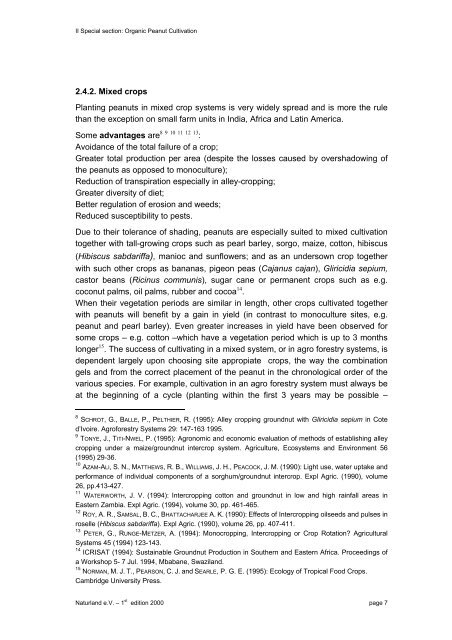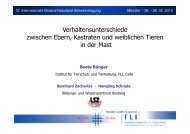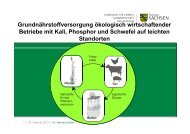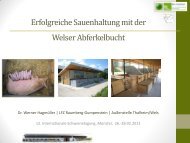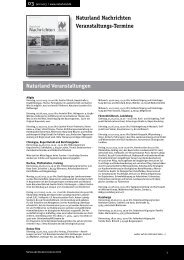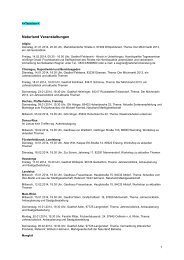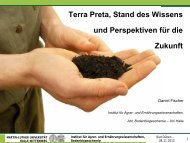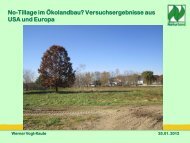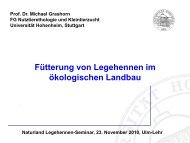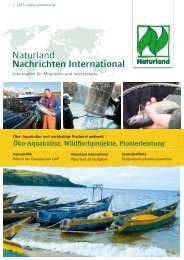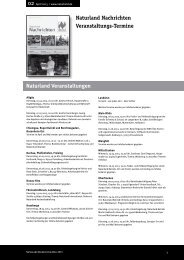Organic Farming in the Tropics and Subtropics: Peanuts - Naturland
Organic Farming in the Tropics and Subtropics: Peanuts - Naturland
Organic Farming in the Tropics and Subtropics: Peanuts - Naturland
You also want an ePaper? Increase the reach of your titles
YUMPU automatically turns print PDFs into web optimized ePapers that Google loves.
II Special section: <strong>Organic</strong> Peanut Cultivation<br />
2.4.2. Mixed crops<br />
Plant<strong>in</strong>g peanuts <strong>in</strong> mixed crop systems is very widely spread <strong>and</strong> is more <strong>the</strong> rule<br />
than <strong>the</strong> exception on small farm units <strong>in</strong> India, Africa <strong>and</strong> Lat<strong>in</strong> America.<br />
Some advantages are 8 9 10 11 12 13 :<br />
Avoidance of <strong>the</strong> total failure of a crop;<br />
Greater total production per area (despite <strong>the</strong> losses caused by overshadow<strong>in</strong>g of<br />
<strong>the</strong> peanuts as opposed to monoculture);<br />
Reduction of transpiration especially <strong>in</strong> alley-cropp<strong>in</strong>g;<br />
Greater diversity of diet;<br />
Better regulation of erosion <strong>and</strong> weeds;<br />
Reduced susceptibility to pests.<br />
Due to <strong>the</strong>ir tolerance of shad<strong>in</strong>g, peanuts are especially suited to mixed cultivation<br />
toge<strong>the</strong>r with tall-grow<strong>in</strong>g crops such as pearl barley, sorgo, maize, cotton, hibiscus<br />
(Hibiscus sabdariffa), manioc <strong>and</strong> sunflowers; <strong>and</strong> as an undersown crop toge<strong>the</strong>r<br />
with such o<strong>the</strong>r crops as bananas, pigeon peas (Cajanus cajan), Gliricidia sepium,<br />
castor beans (Ric<strong>in</strong>us communis), sugar cane or permanent crops such as e.g.<br />
coconut palms, oil palms, rubber <strong>and</strong> cocoa 14 .<br />
When <strong>the</strong>ir vegetation periods are similar <strong>in</strong> length, o<strong>the</strong>r crops cultivated toge<strong>the</strong>r<br />
with peanuts will benefit by a ga<strong>in</strong> <strong>in</strong> yield (<strong>in</strong> contrast to monoculture sites, e.g.<br />
peanut <strong>and</strong> pearl barley). Even greater <strong>in</strong>creases <strong>in</strong> yield have been observed for<br />
some crops – e.g. cotton –which have a vegetation period which is up to 3 months<br />
longer 15 . The success of cultivat<strong>in</strong>g <strong>in</strong> a mixed system, or <strong>in</strong> agro forestry systems, is<br />
dependent largely upon choos<strong>in</strong>g site appropiate crops, <strong>the</strong> way <strong>the</strong> comb<strong>in</strong>ation<br />
gels <strong>and</strong> from <strong>the</strong> correct placement of <strong>the</strong> peanut <strong>in</strong> <strong>the</strong> chronological order of <strong>the</strong><br />
various species. For example, cultivation <strong>in</strong> an agro forestry system must always be<br />
at <strong>the</strong> beg<strong>in</strong>n<strong>in</strong>g of a cycle (plant<strong>in</strong>g with<strong>in</strong> <strong>the</strong> first 3 years may be possible –<br />
8<br />
SCHROT, G., BALLE, P., PELTHIER, R. (1995): Alley cropp<strong>in</strong>g groundnut with Gliricidia sepium <strong>in</strong> Cote<br />
d’Ivoire. Agroforestry Systems 29: 147-163 1995.<br />
9<br />
TONYE, J., TITI-NWEL, P. (1995): Agronomic <strong>and</strong> economic evaluation of methods of establish<strong>in</strong>g alley<br />
cropp<strong>in</strong>g under a maize/groundnut <strong>in</strong>tercrop system. Agriculture, Ecosystems <strong>and</strong> Environment 56<br />
(1995) 29-36.<br />
10<br />
AZAM-ALI, S. N., MATTHEWS, R. B., WILLIAMS, J. H., PEACOCK, J. M. (1990): Light use, water uptake <strong>and</strong><br />
performance of <strong>in</strong>dividual components of a sorghum/groundnut <strong>in</strong>tercrop. Expl Agric. (1990), volume<br />
26, pp.413-427.<br />
11<br />
WATERWORTH, J. V. (1994): Intercropp<strong>in</strong>g cotton <strong>and</strong> groundnut <strong>in</strong> low <strong>and</strong> high ra<strong>in</strong>fall areas <strong>in</strong><br />
Eastern Zambia. Expl Agric. (1994), volume 30, pp. 461-465.<br />
12<br />
ROY, A. R., SAMSAL, B. C., BHATTACHARJEE A. K. (1990): Effects of Intercropp<strong>in</strong>g oilseeds <strong>and</strong> pulses <strong>in</strong><br />
roselle (Hibiscus sabdariffa). Expl Agric. (1990), volume 26, pp. 407-411.<br />
13<br />
PETER, G., RUNGE-METZER, A. (1994): Monocropp<strong>in</strong>g, Intercropp<strong>in</strong>g or Crop Rotation? Agricultural<br />
Systems 45 (1994) 123-143.<br />
14<br />
ICRISAT (1994): Susta<strong>in</strong>able Groundnut Production <strong>in</strong> Sou<strong>the</strong>rn <strong>and</strong> Eastern Africa. Proceed<strong>in</strong>gs of<br />
a Workshop 5- 7 Jul. 1994, Mbabane, Swazil<strong>and</strong>.<br />
15<br />
NORMAN, M. J. T., PEARSON, C. J. <strong>and</strong> SEARLE, P. G. E. (1995): Ecology of Tropical Food Crops.<br />
Cambridge University Press.<br />
Naturl<strong>and</strong> e.V. – 1 st edition 2000 page 7


